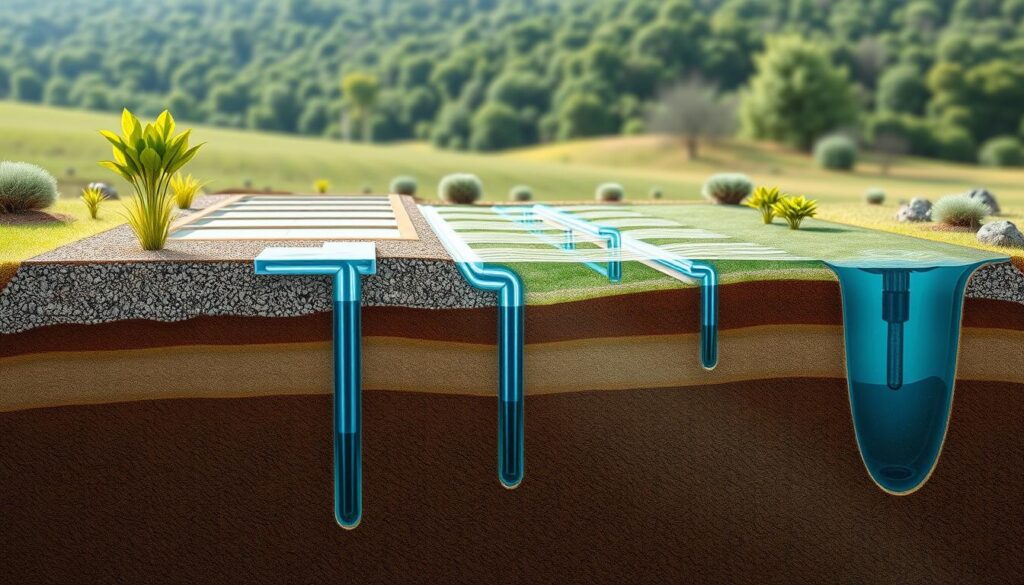As the world grapples with the challenges of water scarcity, the importance of groundwater replenishment cannot be overstated. Are our current methods of managing water resources sufficient to meet future demands? The answer lies in understanding and implementing effective aquifer recharge systems. These systems play a crucial role in maintaining healthy groundwater levels, improving water quality, and ensuring sustainable water management.
Managed Aquifer Recharge (MAR) is a technique that involves the purposeful recharge of water to aquifers for subsequent recovery or environmental benefit. For a deeper dive into MAR and its applications, visit our detailed guide on Managed Aquifer Recharge.
Key Takeaways
- Understanding the importance of groundwater replenishment in sustainable water management.
- Exploring the different methods of aquifer recharge and their benefits.
- Recognizing the challenges associated with implementing aquifer recharge systems.
- Learning from successful examples of Managed Aquifer Recharge (MAR) around the world.
- Appreciating the role of aquifer recharge in enhancing drought resilience.
Understanding Aquifers and Their Importance
Understanding aquifers is essential for managing our water resources effectively, as they are a primary source of freshwater. Aquifers are underground layers of permeable rock or soil that store significant amounts of water, playing a crucial role in supplying freshwater to communities and ecosystems.
What is an Aquifer?
An aquifer is an underground layer of permeable rock or soil that can store and transmit large amounts of water. These geological formations act as natural reservoirs, supplying freshwater to wells and springs. According to the United States Geological Survey (USGS), aquifers are a critical component of the global water cycle, providing water for human consumption, agriculture, and ecosystems.
Types of Aquifers
Aquifers can be classified into different types based on their geological characteristics and the way they store water. The main types include:
- Unconfined Aquifers: These aquifers are not under pressure and are recharged directly from the surface.
- Confined Aquifers: These are under pressure and are sandwiched between layers of impermeable rock.
- Leaky Aquifers: These aquifers allow water to seep through the confining layers.
The Role of Aquifers in Water Supply
Aquifers play a vital role in maintaining the balance of our water resources. They supply water to communities through wells and springs, support agriculture through irrigation, and maintain healthy ecosystems by feeding into rivers and wetlands. Effective management of aquifers is crucial for ensuring sustainable water supplies, especially in areas where surface water is scarce. Techniques such as aquifer storage and recovery and groundwater recharge strategies are being implemented to enhance the availability of freshwater.
Moreover, understanding the role of aquifers in the water cycle is essential for implementing water infiltration techniques that can help recharge these underground reservoirs. By managing aquifers sustainably, we can ensure a reliable source of freshwater for future generations.
What are Aquifer Recharge Systems?
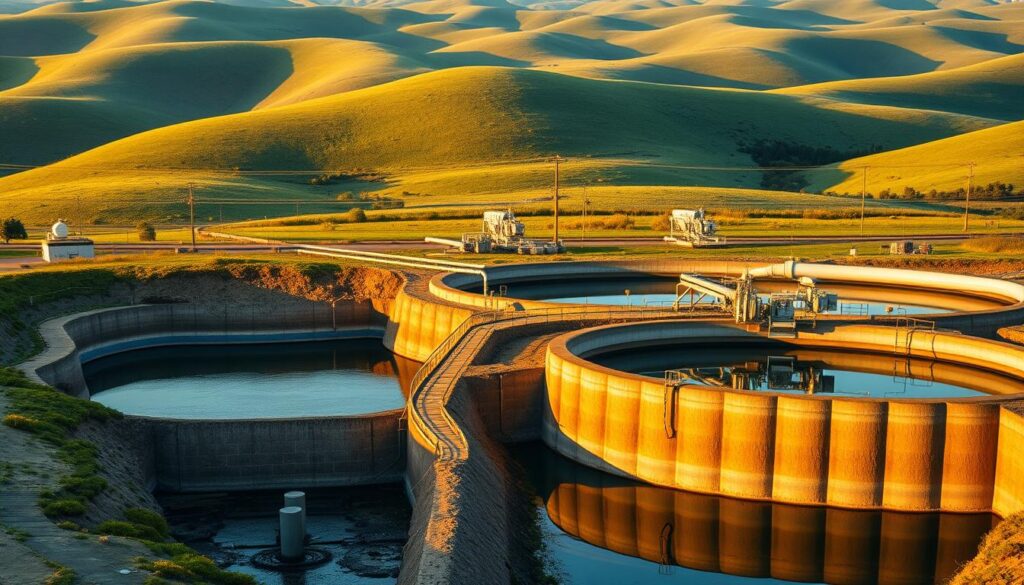
Managed aquifer recharge systems are designed to enhance groundwater supplies. These systems play a crucial role in maintaining healthy aquifers, which are vital for supplying freshwater to communities, agriculture, and ecosystems.
Definition and Purpose
Aquifer recharge systems involve the intentional recharge of water to aquifers to enhance groundwater levels and quality. The primary purpose of these systems is to replenish aquifers, which can become depleted due to over-extraction or reduced natural recharge.
Key components of aquifer recharge systems include:
- Infiltration basins
- Recharge wells
- Permeable pavement systems
These components work together to facilitate the recharge process, ensuring that water infiltrates the ground and recharges the aquifer.
“The use of managed aquifer recharge can significantly improve groundwater levels and quality, providing a sustainable solution for water management.” – Water Management Expert
Benefits of Aquifer Recharge Systems
Aquifer recharge systems offer numerous benefits, including:
| Benefit | Description |
|---|---|
| Enhanced Groundwater Supplies | Recharging aquifers increases the available groundwater, supporting drinking water supplies, agriculture, and ecosystems. |
| Improved Drought Resilience | By maintaining healthy aquifer levels, communities can better withstand droughts and water shortages. |
| Water Quality Improvement | Aquifer recharge can help improve water quality by diluting contaminants and reducing the concentration of pollutants. |
The benefits of aquifer recharge systems are multifaceted, making them an essential tool in sustainable water management.
How Aquifer Recharge Works
Understanding how aquifer recharge works is fundamental to managing groundwater effectively. Aquifer recharge is the process by which water is added to the aquifer, either naturally or through human intervention.
Natural Recharge Processes
Natural recharge occurs primarily through precipitation and surface water infiltration. When rain falls or snow melts, some of the water seeps into the soil and percolates downward to recharge the aquifer. This process is influenced by factors such as soil type, vegetation cover, and the amount of rainfall. For instance, areas with permeable soils like sand or gravel tend to have higher recharge rates compared to areas with less permeable soils like clay.
Surface water bodies like rivers, lakes, and wetlands also contribute to natural recharge. The rate of recharge from these sources depends on factors such as the hydraulic conductivity of the surrounding soil and the water level in the surface water body relative to the groundwater level.
Man-Made Recharge Techniques
In addition to natural processes, aquifer recharge can be enhanced or facilitated through man-made techniques. These include the construction of infiltration basins and the use of injection wells. Infiltration basins are shallow depressions in the ground that collect and store surface water, allowing it to infiltrate into the soil and recharge the aquifer.
Injection wells, on the other hand, involve directly injecting treated water into the aquifer. This method is particularly useful for recharging deep aquifers that are not readily accessible through natural recharge processes. According to the California Department of Water Resources, capturing water from storms to replenish stressed groundwater basins is a critical strategy for enhancing groundwater supplies.
Man-made recharge techniques can significantly augment natural recharge, especially in areas where groundwater is heavily relied upon for drinking water, agriculture, or industry. By implementing these techniques, communities can help maintain healthy aquifers, mitigate the effects of drought, and ensure a more sustainable water supply.
Types of Aquifer Recharge Systems

Understanding the types of aquifer recharge systems is essential for selecting the most appropriate method for a specific region. Aquifer recharge systems are designed to replenish groundwater resources, and their effectiveness depends on various factors, including hydrological conditions and water management needs.
Surface Recharge Methods
Surface recharge methods involve allowing water to infiltrate the ground surface. This can be achieved through flooding or spreading basins, where water is distributed over a large area to maximize infiltration. Surface recharge is particularly effective in areas with permeable soils.
Another surface recharge technique is the use of ditches or furrows, which can be especially useful in agricultural areas. These methods help to enhance groundwater recharge while also providing water for crops.
Subsurface Recharge Techniques
Subsurface recharge techniques involve recharging aquifers directly through underground formations. One common method is the use of injection wells, which pump water directly into the aquifer. This technique is particularly useful for aquifer storage and recovery (ASR) systems, where water is stored in the aquifer during wet periods for use during dry periods.
Subsurface recharge can also be achieved through recharge shafts or drains, which facilitate the movement of water from the surface to the aquifer. These methods are effective in areas where the aquifer is overlain by less permeable layers.
Direct and Indirect Recharge
Recharge systems can be categorized into direct and indirect recharge methods. Direct recharge involves the intentional introduction of water into the aquifer, typically through injection wells or recharge basins. Indirect recharge, on the other hand, occurs when water is introduced into the aquifer through natural processes, such as riverbed infiltration or leakage from surface water bodies.
Managed aquifer recharge (MAR) systems often employ a combination of direct and indirect recharge techniques to maximize the effectiveness of aquifer replenishment. By understanding the different types of recharge systems, water managers can design and implement the most suitable approach for their specific needs.
Key Components of Aquifer Recharge Systems
Understanding the key components of aquifer recharge systems is essential for implementing sustainable water management practices. These systems are designed to replenish groundwater supplies, and their effectiveness relies on several critical elements.
Infiltration Basins
Infiltration basins are a common feature of aquifer recharge systems. These basins are designed to capture and retain surface water, allowing it to infiltrate the ground and recharge the aquifer. The design of infiltration basins involves careful consideration of factors such as soil permeability, surface area, and water depth.
Recharge Wells
Recharge wells are another crucial component, particularly in areas where surface infiltration is not feasible. These wells are used to directly inject water into the aquifer, bypassing the need for surface infiltration. The construction and operation of recharge wells require careful planning to ensure they are effective and do not contaminate the aquifer.
Permeable Pavement Systems
Permeable pavement systems offer a innovative solution for urban areas, allowing rainwater to percolate through the pavement and into the ground, thereby recharging the aquifer. These systems can be integrated into parking lots, roads, and other urban infrastructure.
The following table summarizes the key characteristics of the components discussed:
| Component | Description | Benefits |
|---|---|---|
| Infiltration Basins | Capture and retain surface water for infiltration | Effective for large-scale recharge, can be designed for multiple uses |
| Recharge Wells | Directly inject water into the aquifer | Ideal for areas with limited surface infiltration, can be used for targeted recharge |
| Permeable Pavement Systems | Allow rainwater to percolate through pavement | Reduces urban runoff, can be integrated into urban planning |
For more information on aquifer recharge systems and their implementation, visit https://www.inowas.com/mar/. Effective aquifer recharge systems are vital for groundwater recharge strategies and contribute significantly to sustainable water management practices.
Design Considerations for Aquifer Recharge
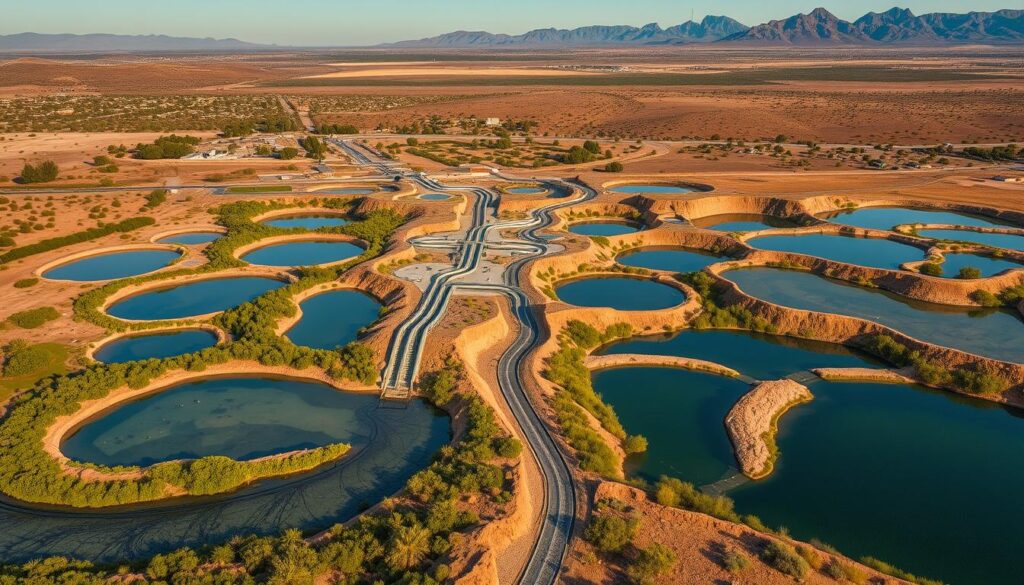
The success of aquifer recharge projects hinges on careful design considerations. Effective managed aquifer recharge systems are those that are designed with a comprehensive understanding of the site’s hydrological characteristics and potential environmental impacts.
Site Evaluation and Assessment
A thorough site evaluation is the foundation of a successful aquifer recharge system. This involves assessing the site’s geology, soil properties, and existing hydrological conditions. Site assessment helps in identifying potential areas for recharge and determining the most effective recharge techniques.
The key factors to consider during site evaluation include:
- Geological stability and soil permeability
- Existing groundwater quality and quantity
- Surface topography and land use patterns
Hydrological Modeling
Hydrological modeling plays a crucial role in designing aquifer recharge systems. It involves simulating various hydrological scenarios to predict the behavior of the aquifer under different recharge conditions. This helps in optimizing the design and operation of the recharge system.
Hydrological models can be used to:
- Predict groundwater flow and recharge rates
- Assess the impact of different recharge strategies
- Evaluate the long-term sustainability of the aquifer
Environmental Impact Assessments
Conducting environmental impact assessments is essential to identify potential risks associated with aquifer recharge. This includes evaluating the potential effects on surface water bodies, ecosystems, and groundwater quality.
| Environmental Factor | Potential Impact | Mitigation Measures |
|---|---|---|
| Surface Water Bodies | Changes in water quality or quantity | Implement buffer zones and monitoring systems |
| Ecosystems | Disruption of habitats or nutrient cycles | Conduct ecological surveys and implement protective measures |
| Groundwater Quality | Contamination from recharge water | Ensure recharge water quality meets or exceeds groundwater quality standards |
By carefully considering these design factors, aquifer recharge systems can be optimized to enhance groundwater replenishment while minimizing environmental impacts.
Legal and Regulatory Framework
Understanding the legal and regulatory framework is crucial for the successful implementation of aquifer recharge systems. This framework is multifaceted, involving various levels of government and different legal considerations.
Federal Regulations
Federal regulations play a significant role in governing aquifer recharge systems. These regulations are primarily focused on ensuring that water quality is maintained and that recharge activities do not harm the environment. For instance, the Safe Drinking Water Act and the Clean Water Act are crucial federal laws that impact aquifer recharge projects.
- The Safe Drinking Water Act regulates the injection of fluids into the ground, including aquifer recharge activities.
- The Clean Water Act addresses water quality standards and pollution control measures.
State and Local Laws
In addition to federal regulations, state and local laws significantly influence aquifer recharge projects. These laws can vary widely, reflecting regional hydrological conditions, legal traditions, and policy priorities.
Some key aspects governed by state and local laws include:
- Water rights and allocations.
- Permitting requirements for recharge facilities.
- Monitoring and reporting obligations.
Water Rights Issues
Water rights issues are a critical component of the legal framework surrounding aquifer recharge. Ensuring that recharge activities comply with existing water rights and do not infringe on the rights of other water users is essential.
Key considerations include:
- Prior appropriation rights.
- Beneficial use requirements.
- Potential impacts on existing water users.
The complexity of the legal and regulatory framework underscores the need for careful planning and compliance in aquifer recharge projects. By understanding and navigating these regulations, stakeholders can ensure that their projects contribute to sustainable water management and groundwater recharge strategies.
Economic Benefits of Aquifer Recharge

Enhancing groundwater supplies through managed aquifer recharge can have profound economic implications. By investing in aquifer recharge systems, communities can reap significant financial benefits that contribute to local economic development.
Cost Analysis of Implementation
The initial investment in aquifer recharge systems can vary widely depending on the technology used and the scale of the project. However, a thorough cost analysis often reveals that these systems can be cost-effective in the long run. For instance, managed aquifer recharge can reduce the need for expensive water treatment processes by improving the quality of groundwater.
- Reduced costs associated with water treatment
- Lower energy costs due to decreased need for pumping water
- Potential savings from avoiding the construction of new water supply infrastructure
Long-Term Financial Savings
Aquifer recharge systems can lead to substantial long-term financial savings. By enhancing groundwater supplies, communities can reduce their reliance on more expensive surface water sources. Additionally, the use of artificial recharge methods can help mitigate the economic impacts of drought by maintaining groundwater levels.
- Reduced expenditure on water supply during droughts
- Savings from decreased water treatment costs
- Economic benefits from maintaining groundwater levels for agricultural and industrial use
Job Creation and Economic Development
The implementation of aquifer recharge systems can also contribute to job creation and local economic development. The construction and maintenance of these systems require skilled labor, thereby generating employment opportunities. Furthermore, by ensuring a reliable water supply, aquifer recharge can support local businesses and industries, fostering economic growth.
| Economic Benefits | Description |
|---|---|
| Job Creation | Employment opportunities in construction, maintenance, and operation of aquifer recharge systems |
| Economic Growth | Support for local businesses and industries through a reliable water supply |
In conclusion, the economic benefits of aquifer recharge systems are multifaceted, encompassing cost savings, long-term financial benefits, and contributions to local economic development. As communities continue to face water management challenges, investing in managed aquifer recharge and artificial recharge methods can be a prudent and economically viable strategy.
Challenges in Aquifer Recharge Implementation
Despite its benefits, aquifer recharge implementation is fraught with technical, environmental, and social hurdles. Effective groundwater replenishment through aquifer recharge systems requires overcoming these challenges to ensure sustainable water management.
Technical Challenges
Aquifer recharge systems face several technical challenges, including the complexity of water infiltration techniques and the need for precise hydrological modeling. Ensuring that water infiltrates the aquifer effectively without causing unintended consequences, such as land subsidence or waterlogging, is a significant technical hurdle.
- Complexity in designing infiltration basins and recharge wells
- Difficulty in predicting and managing aquifer responses to recharge
- Need for advanced hydrological modeling and monitoring systems
For more information on the technical aspects of aquifer recharge, you can refer to studies on groundwater management.
Environmental Concerns
Environmental concerns are another significant challenge in implementing aquifer recharge systems. These concerns include the potential for water quality degradation, impact on local ecosystems, and the risk of inducing seismic activity in certain regions.
- Potential contamination of the aquifer with poor-quality recharge water
- Impact on local ecosystems and biodiversity
- Risks associated with induced seismicity
Addressing these concerns requires a comprehensive environmental impact assessment, as highlighted in discussions on sustainable engineering practices.
Community Resistance
Community resistance is a critical social challenge that can hinder the implementation of aquifer recharge systems. Gaining community acceptance requires education and engagement to address concerns about the project’s impact on local water resources and the environment.
Strategies for overcoming community resistance include:
- Public education campaigns to raise awareness about the benefits of aquifer recharge
- Stakeholder engagement to address local concerns and incorporate community feedback
- Transparency in project planning and operations
In conclusion, addressing the challenges in aquifer recharge implementation requires a multifaceted approach that includes technical innovation, environmental stewardship, and community engagement.
Case Studies of Successful Recharge Systems

Managed aquifer recharge and aquifer storage and recovery techniques have been effectively utilized in various case studies across the United States. These projects demonstrate the potential for groundwater recharge strategies to enhance water supply and support sustainable water management practices.
Examples from California
California has been at the forefront of implementing managed aquifer recharge systems, particularly in regions like the Central Valley. Projects such as the Kern Water Bank Authority’s recharge facilities have successfully recharged significant amounts of water into the aquifer, helping to mitigate the effects of drought and over-extraction.
Highlighting Florida’s Recharge Techniques
Florida has also seen successful aquifer recharge initiatives, particularly through the use of aquifer storage and recovery (ASR) systems. The City of Tampa’s ASR system, for example, has been instrumental in storing treated drinking water in the aquifer during periods of low demand, which can then be recovered during peak usage times.
Success Stories in Texas
Texas has implemented various groundwater recharge strategies, with notable success in the Ogallala Aquifer region. Projects such as the Playa Lakes program have focused on enhancing natural recharge processes through the restoration of playa lakes, which act as natural recharge areas for the aquifer.
These case studies underscore the importance of tailored approaches to aquifer recharge, taking into account local hydrological conditions, regulatory frameworks, and community needs. By leveraging managed aquifer recharge and other groundwater recharge strategies, regions can improve their water security and resilience to climate change.
Innovations in Aquifer Recharge Technologies
Aquifer recharge technologies are evolving rapidly, driven by the need for sustainable water management. As the global demand for water continues to rise, innovative solutions are being developed to enhance the efficiency and effectiveness of aquifer recharge systems.
Emerging Technologies
Several emerging technologies are making significant contributions to the field of aquifer recharge. These include advanced materials for infiltration basins, more efficient recharge wells, and permeable pavement systems that allow for greater water infiltration.
Advanced Materials: New materials are being developed to improve the infiltration rates of basins and enhance the durability of recharge infrastructure.
The use of smart water management systems is another significant innovation. These systems utilize real-time data and monitoring to optimize aquifer recharge operations, ensuring that water is recharged efficiently and effectively.
Use of Smart Water Management Systems
Smart water management systems are revolutionizing the way aquifer recharge is managed. By leveraging technologies such as IoT sensors, AI, and data analytics, these systems can monitor water levels, quality, and flow rates in real-time.
| Technology | Description | Benefits |
|---|---|---|
| IoT Sensors | Monitor water levels and quality | Real-time data for optimized recharge |
| AI and Data Analytics | Analyze data for predictive insights | Improved decision-making |
| Smart Recharge Systems | Automate recharge processes | Enhanced efficiency and reduced costs |
These innovations are crucial for enhancing groundwater supplies and ensuring sustainable water management practices. As technology continues to evolve, we can expect even more efficient and effective aquifer recharge systems.
Monitoring and Maintenance of Recharge Systems
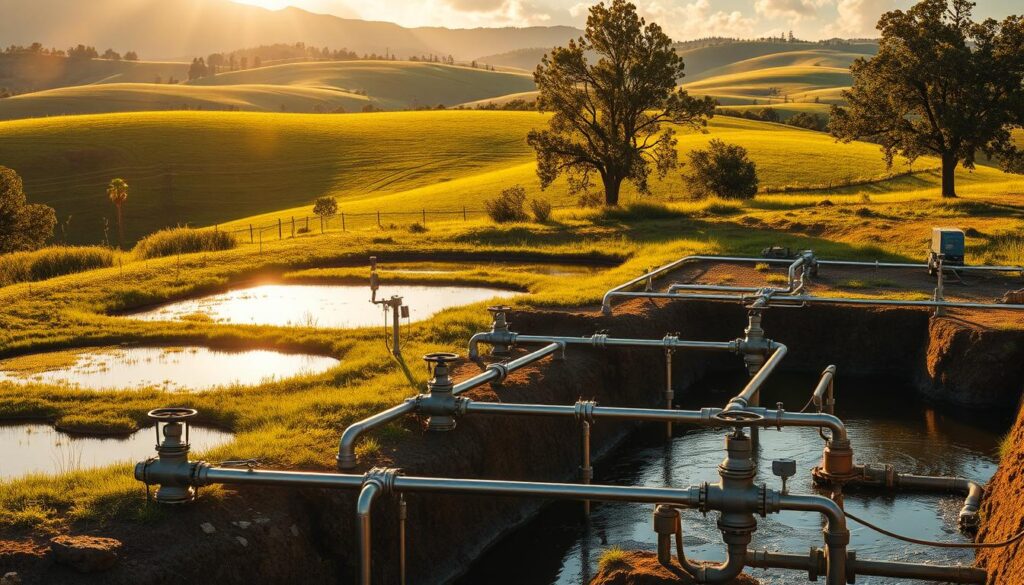
Monitoring and maintenance are crucial for ensuring the efficacy of aquifer recharge systems over time. Regular checks help identify potential issues before they become major problems, ensuring the long-term sustainability of groundwater replenishment efforts.
The importance of regular monitoring cannot be overstated. It involves tracking water quality, flow rates, and the overall health of the recharge system. This proactive approach enables operators to make informed decisions and adjustments as needed.
Importance of Regular Monitoring
Regular monitoring is vital for several reasons:
- Early Detection of Issues: Identifying problems early can prevent costly repairs and ensure continuous operation.
- Optimized Performance: Monitoring data helps in optimizing the system’s performance, enhancing water infiltration techniques.
- Compliance with Regulations: Many jurisdictions require regular monitoring to ensure compliance with environmental and water quality standards.
Maintenance Best Practices
Effective maintenance is key to the longevity of aquifer recharge systems. Best practices include:
- Regular Inspection: Regularly inspect all components of the recharge system for signs of wear or damage.
- Cleaning and Replacement: Clean or replace filters, pipes, and other components as needed to maintain optimal flow rates and water quality.
- Record Keeping: Maintain detailed records of maintenance activities, monitoring data, and any repairs or upgrades.
By prioritizing monitoring and maintenance, operators of aquifer recharge systems can ensure the continued effectiveness of their groundwater replenishment efforts, supporting sustainable water management practices.
Community Involvement and Awareness
Community awareness and involvement are key factors in the implementation of sustainable groundwater recharge strategies. The success of aquifer recharge projects depends on the active participation of local stakeholders, which can be fostered through effective engagement and education.
Engaging Local Stakeholders
Engaging local stakeholders is a critical step in the development of aquifer recharge systems. This involves identifying key community members, understanding their concerns, and addressing them through tailored outreach programs. Public meetings and workshops can serve as effective platforms for disseminating information and gathering feedback.
By involving the community in the planning process, aquifer recharge projects can gain broader support and ensure that the solutions implemented are acceptable and beneficial to the local population.
Educational Programs and Workshops
Educational programs play a vital role in raising awareness about the importance of managed aquifer recharge and the benefits it offers. Workshops can be designed to educate the public on the technical aspects of aquifer recharge, its environmental benefits, and how it contributes to sustainable water management.
- Organizing community events to promote aquifer recharge initiatives.
- Developing educational materials that are accessible to a wide audience.
- Collaborating with local schools to integrate aquifer recharge topics into their curriculum.
Through these efforts, communities can become more informed and invested in the success of aquifer recharge projects, ultimately contributing to more effective and sustainable water resource management.
Future Trends in Aquifer Recharge Systems
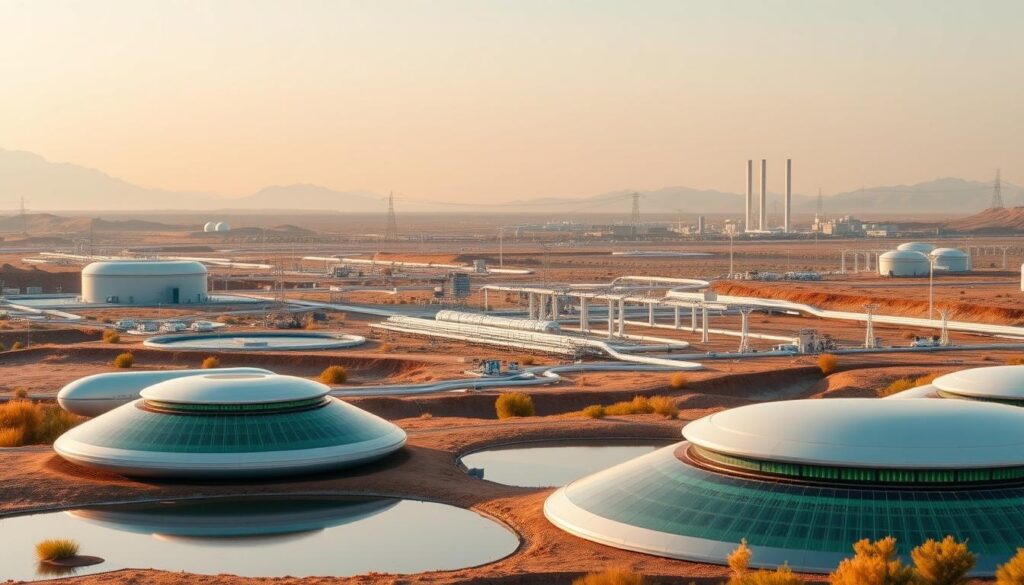
The future of aquifer recharge systems will be shaped by a complex interplay of emerging technologies and evolving regulatory landscapes. As the demand for efficient and sustainable water management practices grows, the industry is poised to adopt innovative solutions that enhance groundwater supplies.
Anticipated Changes in Regulations
Regulatory frameworks governing aquifer recharge are expected to evolve, driven by the need for more effective groundwater management. Anticipated changes include stricter guidelines on water quality, enhanced monitoring requirements, and more transparent reporting mechanisms.
A key aspect of these regulatory changes will be the integration of advanced technologies for monitoring and managing aquifer recharge systems. This could involve the use of real-time data analytics and IoT devices to track water levels, quality, and recharge rates more accurately.
| Regulatory Aspect | Current Status | Anticipated Change |
|---|---|---|
| Water Quality Standards | Existing guidelines | Stricter standards |
| Monitoring Requirements | Periodic monitoring | Real-time monitoring |
| Reporting Mechanisms | Annual reports | Quarterly reports with enhanced transparency |
Innovations on the Horizon
Innovations in aquifer recharge technologies are rapidly advancing, with a focus on improving efficiency, reducing costs, and enhancing sustainability. Some of the emerging technologies include advanced aquifer storage and recovery (ASR) techniques, more efficient artificial recharge methods, and innovative materials for enhancing groundwater supplies.
One of the significant innovations is the use of smart water management systems that integrate data analytics, IoT sensors, and AI to optimize aquifer recharge operations. These systems enable real-time monitoring and adjustments, improving the overall efficiency of the recharge process.
- Advanced ASR techniques
- Efficient artificial recharge methods
- Innovative materials for groundwater enhancement
- Smart water management systems
As these trends continue to evolve, the future of aquifer recharge systems will be characterized by increased efficiency, sustainability, and resilience. By embracing these changes, the industry can better meet the challenges of water management in a changing world.
Conclusion: The Role of Aquifer Recharge in Sustainable Water Management
Aquifer recharge systems play a vital role in maintaining healthy groundwater levels, ensuring a sustainable water supply for future generations. By enhancing groundwater replenishment, these systems contribute significantly to sustainable water management.
Key Takeaways
The comprehensive guide has highlighted the importance of aquifer recharge systems, from understanding aquifers to the various techniques and technologies available for managed aquifer recharge.
Moving Forward
As we move forward, it is essential for stakeholders to support and implement aquifer recharge systems, promoting sustainable water management practices that benefit both the environment and communities. Effective managed aquifer recharge strategies can help mitigate the impacts of climate change, ensuring a resilient water supply.
By working together to adopt and enhance aquifer recharge systems, we can safeguard our groundwater resources, supporting a sustainable future.
